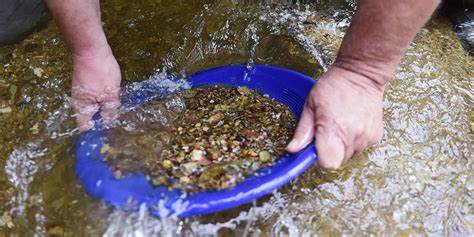
Streams and rivers are nature's sluice boxes, constantly moving and revealing hidden treasures for eager prospectors. However, knowing when to explore these waterways can significantly increase your chances of finding those coveted gold nuggets. This guide will provide detailed tips and tricks on when and where to look in streams while prospecting for gold to maximize your success. Let's dive into the factors that influence the best times to prospect in streams and rivers.
Why Streams Are Ideal for Gold Prospecting
Streams are dynamic environments where water levels and flow rates fluctuate throughout the year, enabling natural processes like erosion and sediment transport to constantly move and expose gold in stream beds. This continuous process means new finds are always possible.
These changes directly impact the types of deposits you'll find. Higher water levels in spring, often due to snowmelt, can carry larger amounts of gold and expose fresh material. Conversely, lower water levels in summer can reveal hidden pockets and concentrated deposits - concentrations of denser minerals like gold left behind by receding waters.
Streams can yield various forms of gold, including flakes, small nuggets, and even larger pieces. The variety of gold makes streams an exciting place for prospectors.
Best Seasons for Stream Gold Prospecting
The best times to prospect in streams vary by season, with each season offering unique opportunities and challenges:
Spring
Spring is a prime time for finding fresh material, especially after the first few warm days following the thaw. The increased water flow during spring can wash away sediments and unveil new treasures, making it easier to spot gold on the stream bed. However, exercise caution due to strong currents. Focus on areas where the water has receded, revealing gravel bars and newly exposed bedrock.
Summer
Lower water levels in summer make it easier to access previously submerged areas, and warmer temperatures offer more comfortable prospecting conditions. Dry spells often concentrate materials in certain areas, making them easier to find. Look for exposed bedrock, gravel bars, and pockets behind obstacles. Summer also provides longer daylight hours, giving prospectors more time to explore. However, it's essential to stay hydrated and protect yourself from the sun while prospecting in the heat.
Fall
Falling leaves and lower water levels continue to provide good visibility and access to stream beds. Fall is a great time to find gold that has been uncovered by summer's low water levels and early autumn rains. Explore stream banks where leaves may have uncovered hidden deposits. Cooler temperatures can also make for a more comfortable prospecting experience. Moderate water levels and fallen leaves create a picturesque setting for prospecting.
Winter
While not ideal in all regions, mild winter days can still offer good prospecting opportunities. Ice and snow melt can expose gold, but be cautious of icy conditions and ensure safe access to streams. In some areas, winter can be a good time to find gold that has been left exposed by the lower water levels and less vegetation. Generally, avoid prospecting in streams during winter due to freezing temperatures, icy conditions, and safety hazards.
Ideal Weather Conditions
Weather plays a crucial role in stream gold prospecting:
1. After Rain or Storms
Heavy rain and storms can significantly alter stream beds, washing away sediment and exposing new gold deposits. The days immediately following a storm are often the most productive. Rainwater can also clean the surface of rocks and sediment, making the gold more visible. However, be cautious of high water levels and strong currents after a storm.
2. During Dry Spells
Extended dry periods lower water levels, making it easier to access deeper parts of the stream bed. This can reveal gold that is normally submerged. Dry spells can also concentrate gold in certain areas, making it easier to find. Be sure to carry enough water and stay protected from the sun.
3. Avoiding Extreme Weather
Avoid prospecting during severe weather conditions, such as thunderstorms, flash floods, or extreme cold. Safety should always be a priority. Check the weather forecast before heading out, and be prepared to adjust your plans if the weather conditions become unfavorable.
Time of Day
The time of day can also influence your prospecting success:
Morning
Early morning offers cooler temperatures and the best light for spotting gold. The calm water often provides clearer visibility. Morning is also a good time to find gold that may have been uncovered by overnight water flow or early morning dew. The quiet and peaceful environment can enhance the prospecting experience.
Afternoon
Midday can be productive, but the heat and glare from the sun might make it harder to see into the water. Use polarized sunglasses to reduce glare. If prospecting in the afternoon, take breaks to avoid heat exhaustion and stay hydrated. The afternoon light can also create interesting reflections and highlights on the water, making certain gold pieces more visible.
Evening
Late afternoon and early evening provide softer light and cooler temperatures. Be mindful of the approaching dusk and ensure you have enough daylight to safely navigate the stream. The evening can be a great time to prospect as the setting sun creates beautiful lighting conditions, highlighting the colors and textures of the gold. The cooler temperatures can also make for a more comfortable experience.
Overcast Days
Overcast skies provide even lighting, reducing glare and enhancing the visibility of details on gold.
Specific Locations within the Stream to Prospect
Certain areas within a stream tend to concentrate different types of gold deposits:
- Inside Bends: Slower water flow often deposits lighter materials like fine gold and smaller flakes on inside bends.
- Outside Bends: Faster water flow can expose bedrock and concentrate heavier gold deposits on outside bends.
- Downstream of Obstacles: Gold can get trapped behind or below obstacles like boulders or fallen trees.
- Gravel Bars: These are prime locations for finding various gold deposits that have been transported downstream.
Safety Considerations
Safety is paramount when prospecting in streams:
Stream Safety Tips
Always be aware of the current and depth of the water. Avoid fast-flowing or deep water, and use a sturdy walking stick for balance. Wear appropriate footwear with a good grip to prevent slipping on wet rocks. Be cautious of hidden underwater obstacles, such as sharp rocks or debris. If prospecting in remote areas, let someone know your plans and estimated return time.
Weather-Related Hazards
Check the weather forecast before heading out. Be aware of the risk of flash floods, especially in narrow valleys and canyons. Sudden rainstorms can cause water levels to rise quickly, creating dangerous conditions. If you hear thunder or see dark clouds approaching, seek higher ground immediately. Always have an emergency plan in place.
Proper Gear and Equipment
Wear appropriate footwear with good grip, such as wading boots or water shoes. Bring a backpack with essential supplies, including water, snacks, a first-aid kit, and a map or GPS device. A hat and sunscreen are also important to protect against sunburn. Carry a waterproof container for your finds and a small towel to dry your hands and equipment. A whistle and a flashlight can be useful for signaling and navigation in low-light conditions.
Recommended Tools & Gear
Techniques for Stream Gold Prospecting
Use effective techniques and tools to maximize your finds:
Tools and Methods
- A small hand rake or trowel can help sift through gravel and sediment.
- A gold pan can be useful for separating lighter materials from heavier gold deposits.
- Use a small mesh screen to sift through fine sediments and uncover smaller gold flakes.
- A magnifying glass or hand lens can help you closely inspect your finds.
- A rock hammer and chisel can be useful for breaking larger rocks to reveal hidden gold.
Tips for Collecting and Preserving Finds
- Bring small containers or bags to store your finds. Label them with the date and location for future reference.
- Clean your gold specimens with water and a soft brush before storing them.
- Avoid using harsh chemicals or abrasive materials, as they can damage delicate gold pieces.
- If you find a particularly interesting or valuable specimen, consider taking photos before and after cleaning to document its condition.
Additional Tips for Stream Gold Prospecting Success
- Research and Permits: Research local regulations and obtain any necessary permits before you start.
- Local Knowledge: Talk to experienced prospectors or join a local club to learn about productive streams and hidden hotspots in your area.
Gold prospecting in streams is a rewarding activity that offers the chance to find unique and valuable specimens. By understanding the best times and conditions for searching streams, you can enhance your prospecting success. Remember to prioritize safety, respect the environment, and enjoy the adventure of discovering the hidden treasures that streams have to offer. Each trip to a stream is an opportunity to learn more about the natural world and uncover the beauty of gold. Whether you're a beginner or an experienced prospector, the thrill of finding a new gold nugget never gets old. So grab your gear, head to a stream, and see what treasures await you. Happy prospecting!




